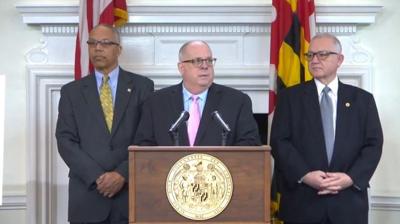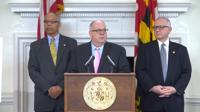ANNAPOLIS, Md. (WBOC/AP)- Maryland Gov. Larry Hogan is providing some highlights of his budget proposal.
Hogan said Tuesday it will include about $6.5 billion for K-12 education, a record amount for the state.
Hogan says every single school system in Maryland will see increased funding. The governor says the state is investing an additional $365 million more in school construction, bringing the total to $1.4 billion.
The budget also contains $1.38 billion for the University of Maryland, an increase over last year.
“For nearly three years, our administration has pledged to bring fiscal restraint to Annapolis and to hold the line on spending, and we have," Hogan said. “We vowed to fund priorities like education, transportation, and health care and we have done exactly what we said we would do.”
The Republican governor is meeting with leading Democrats on Wednesday morning to talk about the budget for the next fiscal year. Hogan also will make the entire budget public on Wednesday. Lawmakers will spend much of the 90-day session working on the governor's budget proposal.
Below are highlights of the FY 2018 budget:
Investing in Education:
- For the fourth consecutive year, the Hogan administration is providing record funding for K-12 education. The FY 2019 budget includes a $6.5 billion state investment in Maryland’s public schools, fully funding state aid programs.
- Direct aid to local schools grows by $139.2 million, or 2.5 percent.
- The budget goes above and beyond required statutory funding formulas to ensure that every Maryland jurisdiction receives more direct education aid than in FY 2018. Five jurisdictions will receive $15.2 million in FY 2019 to ensure that their direct K-12 education formula aid grows by at least $100,000 over FY 2018: Baltimore City ($11.1 million), Cecil County ($3.4 million), Calvert County ($540,610), Carroll County ($99,799), and Garrett County ($47,626).
- The budget includes $855,000 to continue operations at eight P-TECH 9-14 schools in Maryland, all created as a result of a Hogan administration initiative. Graduates from Maryland’s P-TECH schools will earn their high school diploma and a two-year postsecondary degree in a STEM field from an accredited community college.
- The Broadening Options and Opportunities for Students Today (BOOST) Program grows by $3.5 million to $9 million, continuing the governor’s commitment to double funding for the program over three years. BOOST provides scholarships for low-income students in areas with under-performing schools to attend non-public schools, giving them the opportunity for a better education. This is in addition to the $5.5 million increase approved by the General Assembly last year.
- The budget includes $3 million in grant funding for local boards of education to implement policies and practices that address heroin and opioid addiction and prevention as part of the administration’s comprehensive approach to the opioid crisis.
- The governor’s budget provides $1.38 billion in state funds to the University System of Maryland (USM), a 2.4 percent increase over FY 2018.
- For the third year in a row, tuition growth at Maryland’s public four-year institutions is held to 2 percent, helping to keep higher education affordable for Maryland taxpayers.
- The Sellinger program for Maryland’s independent colleges and universities is funded at $49.8 million.
- The FY 2019 budget invests $11.5 million in additional funding for the Child Care Subsidy Program to end the wait list and to increase subsidy rates paid to providers by 8 percent. Funding totals $90.7 million in FY 2019.
- The governor’s budget provides $96.7 million in state funds to Morgan State University, a $2.3 million, or 2.4 percent, increase over the current year. Two million dollars of these additional funds will support the university’s Cyber Security Center of Excellence.
- State support for St. Mary’s College of Maryland grows by 4.2 percent to $26 million in FY 2019, consistent with legislation passed during the 2017 Session.
- The Cade formula and grant funding for the local community colleges grows to a record level of $261 million in FY 2019, or 2 percent over FY 2018. There is additional funding of $2 million available for community colleges that limit tuition increases to no more than 2 percent in the 2018-2019 academic year.
- Baltimore City Community College receives $39.8 million in state support in FY 2019, level funded from last year.
Creating Jobs and Expanding Opportunities for Businesses:
- The Governor’s budget provides $25 million in FY 2019 and an additional $2.5 million in FY 2018 for the Maryland Economic Development Assistance Authority and Fund (MEDAAF), a substantial investment in the state’s most powerful tool to attract and grow businesses.
- Governor Hogan’s FY 2019 budget includes $10 million for two new tax credits established under 2017’s More Jobs for Marylanders Act. The new credits will create thousands of jobs and attract businesses by reducing state taxes for manufacturing employers that create jobs in qualifying high-unemployment zones.
- The FY 2019 budget distributes a total of $10 million from the “Sunny Day” Fund as part of the administration’s efforts to create and retain jobs in the state, including the final $5 million payment to Northrop Grumman Corporation, and the first $5 million payment to Marriott International, Inc., part of a multiyear, $20 million commitment to ensure that Marriott’s headquarters remains in Maryland.
- Governor Hogan’s budget includes $12 million for the Biotechnology Investment Incentive Tax Credit and $2 million for the Cybersecurity Investment Incentive Tax Credit to capitalize on Maryland’s strategic advantages in these business sectors.
- Governor Hogan’s FY 2019 budget also includes funding for a $33 million multi-year collaborative effort with the University System of Maryland to produce more graduates in key workforce areas such as science, engineering, and cybersecurity.
Tourism and the Arts:
- An all-time high of $21.7 million to the Maryland State Arts Council, which provides grants, technical assistance, and other support services for the arts.
- A combined total of $13.1 million for the Office of Tourism Development – the state’s official marketing agency – and the Maryland Tourism Development Board to stimulate and promote travel and tourism in Maryland.
Building for the Future – Transportation & Infrastructure:
- $2.9 billion in capital spending to improve transportation infrastructure and promote economic development.
- In addition to the $178.1 million in Highway User Revenue funds, the budget includes $53.7 million in capital grants to local jurisdictions to improve local roads and transportation facilities.
Treatment, Safety, and Correctional Services:
- In addition to $159.3 million dedicated to existing, non-Medicaid substance use disorder and addiction programs, the FY 2019 budget includes $13.7 million in spending to augment the state’s response to the heroin/opioid epidemic. This includes the second $10 million installment in the governor’s five-year, $50 million commitment, an additional $3 million enhancement, and $700,000 plus one new position to expand the efforts of the Opioid Operational Command Center.
- In fulfillment of the state’s commitment to increase its capacity to accept court-ordered placements for behavioral health treatment, the FY 2019 budget supports the addition of 82 treatment beds in state facilities as well as expanded access to treatment in the community. The budget provides an additional $3.4 million in FY 2018, $8.1 million in FY 2019, and 33 new positions toward this end.
- Police aid to local governments and municipalities is funded at $74.5 million in FY 2019. Local law enforcement grants total $35.3 million and include an additional $2 million each for the new Maryland Criminal Intelligence Network and a new program of school safety grants for schools and child care centers.
- Consistent with goals of the Justice Reinvestment Act, an additional $1.2 million is provided in FY 2019 to establish a new Community Adult Rehabilitation Center, expanding community assistance, substance abuse programs, rehabilitative services, and job readiness training for DPSCS’s pre-release population.
- The budget includes $6.9 million to improve retention of Correctional Officers at state facilities.
- The FY 2019 budget for the Department of Public Safety and Correctional Services includes $1.4 billion to house and rehabilitate a population of nearly 19,000 inmates, detain arrestees, house pretrial offenders, and supervise nearly 70,000 individuals in the community. This year, the correctional population is projected to fall below 19,000 for the first time since 1992.
Protecting the Environment:
- The fiscal year 2019 budget marks the first time since 2008 that no funding for transfer tax programs – including Program Open Space – is diverted to the General Fund. Programs funded by the transfer tax receive $253 million, an increase of $67 million from FY 2018.
- The Chesapeake and Atlantic Coastal Bays 2010 Trust Fund receives $52.9 million in FY 2019, marking the third year in a row that the Hogan administration has fully funded Bay restoration efforts. Funding for the 2010 Trust Fund under the Hogan administration exceeds the amount provided in the prior four years by 80 percent.
- Total funding for Maryland State Parks under the Hogan administration exceeds the level provided during the prior four years by 25 percent.
Health Care and Public Safety Net:
- The FY 2019 budget includes more than $11.5 billion for Maryland’s Medicaid program, which currently provides basic health coverage to nearly 1.4 million Marylanders, including more than 147,000 children through the Maryland Children’s Health Program.
- The Division of Rehabilitation Services (DORS), which promotes the employment and independence of individuals with disabilities, receives $123.3 million in FY 2019, an increase of $1.6 million. In the past year, the DORS wait list has fallen by 33 percent.
- Funding for Autism Waiver services grows by $2.7 million to $24.4 million, enabling an additional 100 children to receive services in their community rather than in more restrictive and expensive institutional settings. Under the Hogan administration, the number of children served by the program has grown by 20 percent.
- Nearly $52 million is provided in FY 2019 to fund a 2 percent rate increase for behavioral health service providers and a 1 percent rate increase for most other health care and group home providers. This budget includes $11 million for the Developmental Disabilities Administration to benefit direct care workers serving some of Maryland’s most vulnerable citizens.
- An additional $17.6 million is included to bring physician rates under Medicaid up to 93 percent of Medicare rates.
- The FY 2019 budget includes $1 billion in federal Supplemental Nutrition Assistance Program (SNAP) benefits for more than 364,000 households, $3.1 million in supplemental SNAP benefits for more than 18,000 households with a member aged 62 or greater, $116.4 million in heating and electricity assistance benefits for 218,000 households, and $29.5 million to provide cash, medical, and housing benefits to 13,000 people with disabilities.





